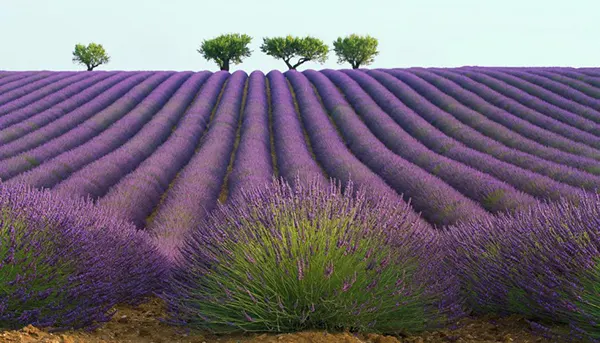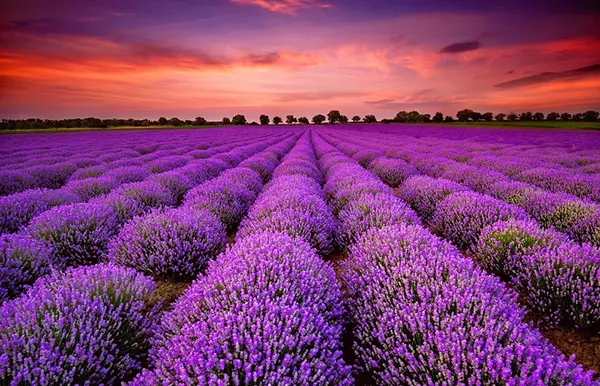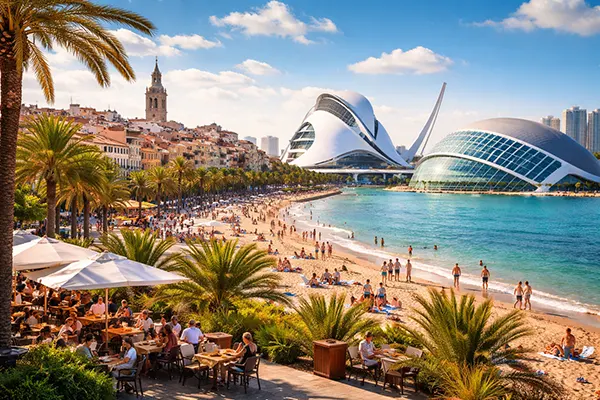
Provence, France – Lavender Fields and Rural Charm
Provence is one of the most picturesque and peaceful regions in southeastern France, known globally for its lavender fields, traditional villages, and Mediterranean charm. With its warm climate, cultural richness, and slow-paced lifestyle, it has become a favourite destination for travellers in search of authenticity and relaxation. February might not be the prime lavender season, but it offers an opportunity to explore the region without the crowds, discovering the essence of Provençal life beyond the flower bloom.
The Essence of Provence in Winter
Visiting Provence in February presents a unique side of the region, far removed from its usual summer image. The towns and villages are quieter, offering a more intimate experience. Locals go about their everyday routines, bakeries continue to produce fresh pain de campagne, and weekly markets still fill the squares with local produce, cheeses, and olives. The cooler weather makes it perfect for exploring on foot, from cobbled alleys in Gordes to hillside paths around Roussillon.
Although the lavender is not blooming in February, the surrounding countryside still offers a colourful landscape. Olive trees, cypress lines, and ochre cliffs provide a scenic backdrop for hikers and cyclists alike. The fields remain iconic, stretching across the plains, hinting at their summer glory. This season allows visitors to appreciate the agricultural landscape in a raw, unembellished form, which holds its own quiet charm.
For those interested in culture and history, the off-season is ideal. Museums such as the Musée de la Lavande in Cabrières-d’Avignon or the Fondation Vincent van Gogh in Arles are less crowded, allowing time and space to absorb the artistry and history that define the region. Medieval ruins and Roman amphitheatres stand undisturbed, providing a contemplative atmosphere for those who seek deeper connections with the past.
Authentic Village Life
In February, Provençal villages reveal their everyday rhythm. Places like Lourmarin, Séguret, and Bonnieux offer glimpses into rural life where tourism takes a back seat. Residents gather at local cafés for morning coffee, discuss the weather at boulangeries, and carry baskets through open-air markets brimming with truffles, root vegetables, and local wines. These moments are snapshots of genuine French countryside life.
Accommodation during this season is both more affordable and flexible. Family-run gîtes, old stone farmhouses, and boutique hotels open their doors with warm hospitality. Many include fireplaces, home-cooked meals using regional ingredients, and personalised itineraries for exploring nearby vineyards and artisanal producers. This homely welcome is a cornerstone of Provençal hospitality.
Moreover, February often includes small community events such as olive oil tastings, indoor art exhibitions, and winter food festivals. These are rarely listed in commercial guides but are cherished by locals and adventurous travellers who value authenticity over spectacle. Engaging with these local rhythms offers a more immersive and rewarding experience than any postcard moment ever could.
Cuisine and Local Products
Provence in winter remains a gourmet haven. Seasonal dishes like daube Provençale (beef stew with red wine and herbs) and soupe au pistou (vegetable soup with basil) are comforting, full-flavoured, and served in almost every village restaurant. Local wines, especially from the Côtes du Rhône and Luberon regions, accompany meals with elegance and warmth.
Markets continue to thrive year-round, and February showcases a different bounty: black truffles, fresh goat cheese, citrus fruits, and robust olive oils. Many producers open their doors for tastings, offering an insight into centuries-old traditions. Whether it’s a cheese cellar carved into a hillside or a rustic vineyard using natural fermentation, the passion of local artisans is palpable.
Gastronomic tourism is a powerful draw, even in the low season. Many visitors plan their itinerary around culinary experiences, from cooking classes in old farm kitchens to wine pairings hosted by local sommeliers. February’s slower pace provides ample time for genuine conversations, generous tastings, and a deeper understanding of Provençal flavours.
Winter Activities and Experiences
Beyond food and scenery, Provence in February offers various enriching activities. The mild climate is ideal for hiking in the Alpilles or exploring the Camargue wetlands, where flamingos and white horses roam freely. These natural parks are vast, serene, and perfect for photography or quiet contemplation.
Art lovers will enjoy walking in Van Gogh’s footsteps through Arles and Saint-Rémy-de-Provence, where many of his most famous works were inspired. Galleries often feature temporary exhibitions during the winter months, highlighting both classical and contemporary Provençal artists. It’s a chance to discover the creative pulse of the region in a relaxed setting.
Finally, spa retreats and thermal baths are increasingly popular in winter. Towns like Gréoux-les-Bains offer soothing escapes where visitors can enjoy warm mineral waters, massages, and holistic treatments while surrounded by the tranquil Provençal landscape. These experiences provide a rejuvenating counterpart to the region’s sensory and cultural delights.

The Timeless Appeal of Provence
What makes Provence irresistible is not only its natural beauty but also its consistent character. Whether basked in lavender or wrapped in winter mists, the region maintains a sense of place rooted in tradition, community, and craftsmanship. February travellers often discover this authenticity more vividly, without the distractions of seasonal tourism.
Each village has its own soul, shaped by centuries of history and shaped again by the daily life of its people. From handwoven baskets and ceramic workshops to old bookshops and wine cellars, the region’s charm lies in the details. These authentic touches tell the story of a land that embraces its past while gracefully adapting to modern needs.
Ultimately, visiting Provence in February is not about what’s missing but about what becomes visible in the quiet: a deeper sense of place, honest connection with locals, and appreciation for simplicity. It is a reminder that beauty doesn’t need to be loud to be powerful — and that sometimes, the softest seasons reveal the strongest impressions.
Travel Tips for a February Visit
When planning a trip to Provence in February, it’s best to dress in layers. Days can be sunny and mild, while evenings often require a warm jacket. Comfortable walking shoes are essential, as the region invites exploration on foot. Many attractions and restaurants remain open year-round, but it’s advisable to check local schedules in smaller villages.
Hiring a car is recommended for maximum flexibility. Public transport is available, but more limited outside urban centres. With a car, visitors can discover remote wineries, hilltop chapels, and family-run auberges not listed in guidebooks. Roads are quiet in winter, making drives through the countryside a pleasure rather than a challenge.
Finally, keep an eye on regional tourism websites and local posters for seasonal events, market days, or temporary exhibitions. These often change year by year and offer delightful, unexpected opportunities. Engaging with the region on its own terms — patiently and curiously — ensures a richer and more meaningful journey.




